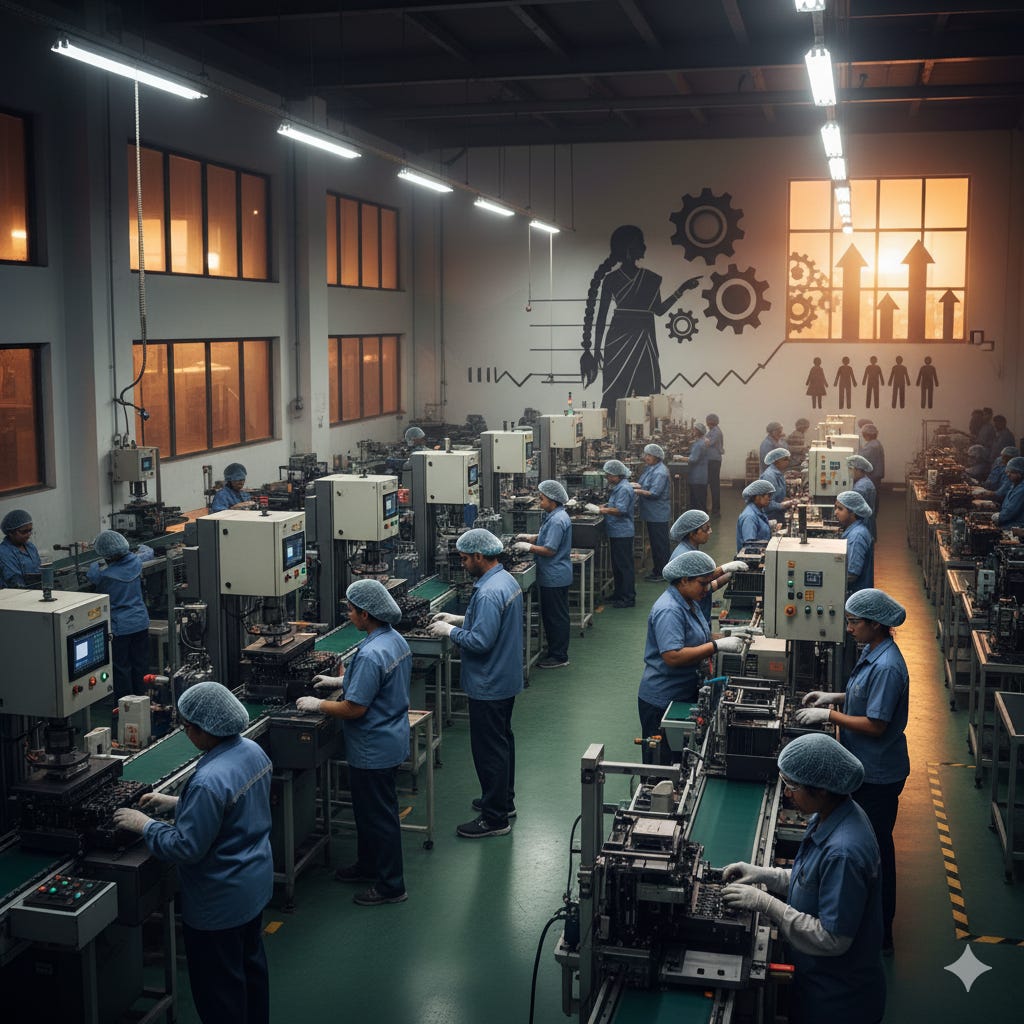Indian Women's Night Shift Revolution: From Protection to Participation
India’s rollback of nightshift bans marks a turning point; enforcement and infrastructure will decide how much it delivers.
View as PDF
Bhanu Gupta, Ashoka University.
Kanika Mahajan, Ashoka University.
Anisha Sharma, Ashoka University.
Daksh Walia, University of Oxford
SDG 5: Gender Equality | SDG 8: Decent Work and Economic Growth
Institutions: Ministry of Labour and Employment
A seven-decade-old clause in the Factories Act barred Indian women from working factory night shifts. That restriction began to unravel in 2000 and has since been lifted across many states. Its end widens opportunity for women and strengthens India’s modern labour market. More than a legal reform, it marks a shift from paternalism to participation – critical in a country where women’s labour force participation remains among the lowest in the G20.
From Prohibition to Participation: A Legal Journey
The ban was written into the Factories Act of 1948, reflecting international conventions of the time. Its roots lay in the International Labour Organization’s Night Work (Women) Convention of 1919, which explicitly prohibited women from working at night. By 1990, however, the ILO had revised its stance, recognising such measures as discriminatory.
In India, the turning point came in 2000, when the Madras High Court struck down the provision as unconstitutional. Other courts soon followed. By the mid-2010s, more than a dozen states, including Andhra Pradesh and Gujarat, had amended rules to permit women to work nights, provided employers ensured secure transport, sanitation and grievance mechanisms for harassment.
Because labour is a concurrent subject under India’s federal system, states moved at different speeds. Some legislated, others relied on executive orders. The result is a patchwork of rules – both an opening for women and a source of regulatory uncertainty for firms operating across state lines.
The real question is whether these uneven legal shifts changed life on the factory floor.
Factories After Reform: Change on the Ground
Evidence from the Annual Survey of Industries covering all large firms and a representative sample of smaller firms, between 2009 and 2019 shows clear effects. In states that lifted restrictions, large factories (over 250 workers) expanded women’s employment: the female share of the workforce rose by 3.5 percent, and the absolute number of women workers increased by about 13 percent. The likelihood of a large factory employing at least one woman also rose by about 6.5 percent.
Crucially, these gains did not come at men’s expense. Firms did not replace male workers with women; they hired more people overall. Lifting restrictions expanded the labour pool, creating jobs rather than redistributing them.
Industry patterns reinforced this logic. Export-oriented firms responded more quickly. Factories in high-unemployment districts were also more responsive. Where competitive pressure or joblessness was high, reform translated faster into practice.
Why Large Firms Led
The effects were strongest among large firms – and for good reason. Compliance with the new requirements – safe transport, separate toilets, functioning harassment committees – demands upfront investment. Bigger companies can spread these costs; smaller enterprises, typically operate on thin margins, struggle.
Firms that already employed women – even if just 5–10 percent of their workforce – were more likely to expand once barriers were lifted. The presence of women appears to normalise inclusion and lower the psychological and organisational costs of hiring more.
The implication is clear: smaller firms remain constrained not by intent but by resources. With targeted support such as shared transport services, cluster-level facilities, or compliance subsidies, they too could benefit more fully from the reform.
Safety, Health and Choice
Infrastructure costs are only part of the story. The original rationale for the ban lay not in economics but in concerns over health and safety.
Night work disrupts the body’s natural sleep–wake cycle, increasing fatigue, cardiovascular strain, and stress. For women, studies also link it to a 20–30 percent higher risk of breast cancer and fertility complications. Concerns about harassment and physical security remain legitimate. Yet the underlying health risks of disrupted night work are not unique to women; they affect all workers. The new framework responds by requiring safeguards so women, like men, can choose whether to take night shifts. This marks a shift from exclusion to empowerment – dignity protected through regulation rather than prohibition.
Globally, India is catching up with a trend. Between 1990 and 2020, more than 30 countries revised or repealed bans that restricted women from working night shifts. The principle is simple: equality is not about shielding women out or leaving them unprotected, but about common safeguards for everyone.
With safeguards in place, the next question is whether inclusion has delivered measurable economic gains.
Economic Outcomes: Cautious Optimism
In the short run, effects are modest. Factories that hired more women have not seen marked gains in productivity or profits. Women still make up only about 10 percent of factory labour, too small a share to transform output immediately. Some firms also substituted labour for capital, reducing machinery investment by around 4 percent as their workforce expanded, a shift that tempered productivity gains but widened employment.
Still, the entry of more women into factory jobs is progress in its own right, even if the productivity impact is not yet visible. Over time, as women’s participation rises, workplace cultures adapt and firms invest in skills and technology, the dividends are likely to grow. The reform should be viewed less as a quick fix than as a foundation for long-term competitiveness.
Global Benchmarks and India’s Stakes
India’s reform is part of a worldwide movement to dismantle discriminatory laws. The ILO itself has shifted from restrictions to rights, and other emerging economies have followed suit.
For India, the stakes are particularly high. Manufacturing contributes roughly 17 percent of GDP and underpins ambitions of sustained growth and deeper integration into global supply chains. Realising that vision will require mobilising the country’s underused female workforce.
Global experience shows the gains from reform, India’s challenge is to translate legal change into workplace reality.
Policy Lessons For Inclusive Growth
The implications for policy are clear. Smaller firms need practical support – shared facilities, reliable transport, targeted subsidies – if inclusion is to spread beyond the factory giants.
Workplace institutions must also be strengthened. Enforcing sexual harassment laws and grievance mechanisms is essential to sustain women’s participation in night work. Legal equality without cultural and institutional follow-through will achieve little.
These steps will take time. Allowing women into night shifts will not by itself deliver gender parity or an export boom. But it marks a decisive break with a paternalistic past. If legal change opens the door, enforcement and infrastructure are the keys - and India must now turn them.
View as PDF
Authors:

The discussion in this article is based on the authors’ working paper on the subject. Views are personal.


